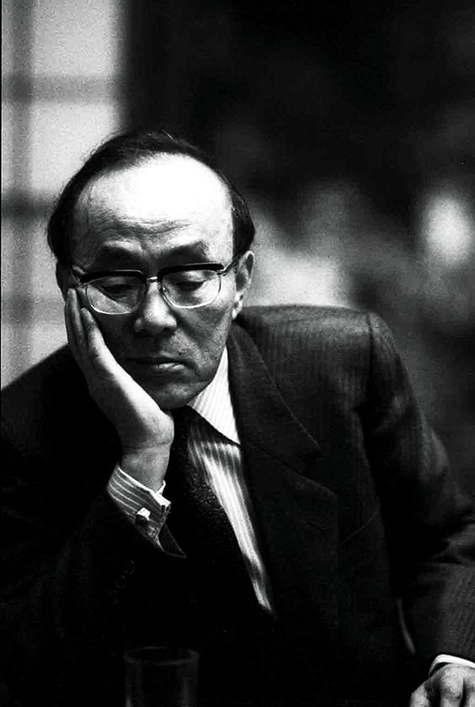Shūsaku Endō

27 March: SE born in Tokyo
Soon after his birth, his family moves to China.
SE's parents divorce; his mother brings him to Kobe, where they live with her sister.
SE's aunt convinvces him to convert to Roman Catholicism.
SE attends Waseda University to study medicine.
SE begins studies in writing at Keio University. His studies are interrupted by WWII, when he works in a munitions factory.
SE contributes to literary journals throughout this time.
SE travels to the University of Lyon to study French Catholic novelists, especially François Mauriac, Georges Bernanos, and Paul Claudel. While there he contracts tuberculosis, which manifests as pleurisy, an inflammation of the lining of the lungs.
SE returns to Japan, in poor health from his time abroad.
SE's first novel, Shiroi Hito (White Men) wins the Akutagawa Prize.
A companion novel to his first,,Kiiroi Hito (Yellow Men) is published. The juxtaposition between these first two novels will be fodder for SE's work throughout his career.
SE marries Okada Junko.
SE teaches at Sophia University.
SE and Okada have their only chid, a son, Ryūnosuke.
海と毒薬 (The Sea and Poison ) is published. It is controversial in Japan, because it deals with the torture, medical experiments, and vivisections performed by the Japanese military on American prisoners of war. These included removal of parts of the organs of the POWs, injecting them with seawater, and beheading.
おバカさん (Wonderful Fool ) is published. In it a kind and naive foreigner, a Christ-like figure, visits post-war Tokyo. He befriends a variety of "undesirables" including stray dogs, prostitutes, and a killer.
A collection of short stories, 十一の色硝子 (Stained Glass Elegies ), is also published.
火山 (Volcano ) is published. It is a triptych, with three declining figures: an apostate Catholic priest, the director of a weather station in provincial Japan, and the volcano on which the latter is an expert.
私が棄てた女 (The Girl I Left Behind ) is published. It's a story of a young man and his mismatches with an innocent young woman. As Endō writes in the foreword to the English translation, one of the characters has a connection with Otsu, a character in his later novel Deep River.
留学 (Foreign Studies ) is published. Three linked narratives chart the gulf between East and West. Connecting Paris in the 1960s, 17th-century Rome, and provincial France in the post-WWII years, the novel presents the alienation felt by three Japanese students when confronted by the spiritual values and culture of Europe.
SE's most famous work in the West, 沈黙 (Silence ) is published and wins the Tanizaki Prize. This historical novel tells the story of the failure of Christian missionaries in early 17th-century Japan. The main character is based on the historical figure of Giuseppe Chiara.
SE takes a position as "Lecturer on the Theory of the Novel" at Seijo University.
SE becomes chief editor of one of the most prestigious literary journals in Japan, Mita Bungaku.
イエスの生涯 (Life of Jesus ) is published. Following in a long Christian traditon, SE publishes a take on the life of Christ. The book is shocking for Western Christians, because it ends with the death of Jesus. SE writes that the idea of resurrection is not necesary for Japanese Christianity, and so is not even considered important.
侍 (The Samurai ) is published. This historical novel relates how in 1613 a small group of samurai together with a Spanish missionary travel to Mexico, Spain and eventually Rome. The missionary (Pedro Velasco) hopes to become primate of a Catholic Japan and his mission is to bargain for a crusade to Japan in return for trading rights.
女の一生:キクの場合 (Kiku's Prayer ), a novel set during the final period of Christian persecutions in Japan in the 1860s, is published.
SE meets one of his most significant influences, Graham Greene, the English novelist. The two were in epistolary contact, but in person Greene told SE that “if he was interested in a Nobel Prize” he would be pleased to introduce him to a “very large and famous publisher.” SE refused to accept his offer, as he “wanted to be faithful to the other British publisher who had undertaken to get his first novel translated into English and published.” [Peter Owen]. Greene also told SE that he had just a few years to live and hoped that Endo would continue writing “Catholic” literature as if on his behalf.
Another controversial novel, スキャンダル (Scandal ), is published. The main character, a novelist, goes on a quest in the red-light district of Tokyo, seeking to learn how a lewd portrait of him (or of a Doppelganger) was put on exhibition. He comes to conclude that "deep in the hearts of men lay a blackness they themselves knew nothing about." SE uses this search to explore the conflict between modernity and faith.
深い河 Deep River is published. The novel revisits one of the characters of The Girl I Left Behind. In this text a group of soulless Japanese tourists visit India, and are exposed to a number of religious perspectives, all seemingly equally valid ways of aspiring to spiritual transcendence.
SE is shortlisted for the Nobel prize, but loses to fellow Japanese novelist Kenzaburō Ōe.
29 September: SE dies from complications of hepatitis in a Tokyo hospital.